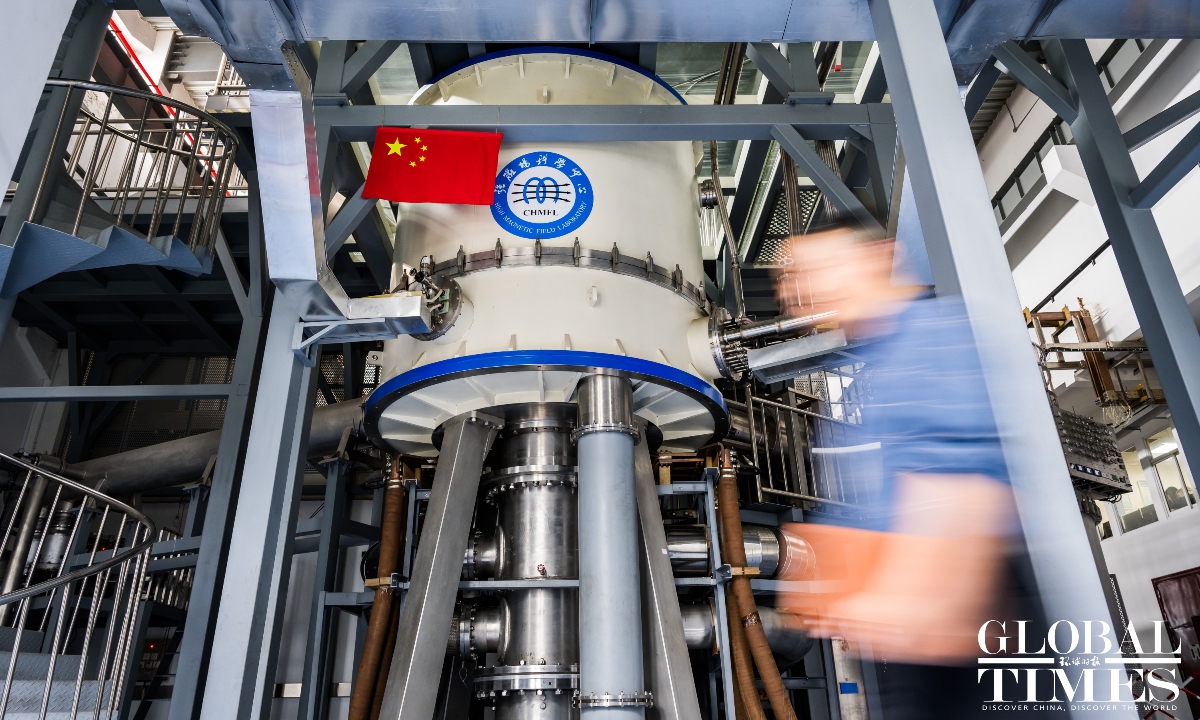
Photo: Chen Tao/GT
China has ramped up efforts to accelerate scientific research and innovation lately. Aided with the state-of-the-art research facilities, a vast and skilled group of young and experienced researchers, as well as strong institutional support, China is now on a par with some leading developed countries in science and technology innovation, a prominent Chinese scientist said.
Surrounded by a huge reservoir and lush vegetation, an islet in Hefei, the provincial capital city of East China's Anhui Province, is an epitome of the cutting-edge research and new tech innovation that supports China's incessant breakthroughs in technological advancement.
The islet, also known as the Science Island, is home to the Steady High Magnetic Field Facility (SHMFF) at the High Magnetic Field Laboratory, the Hefei Institute of Physical Science, a research institute under the Chinese Academy of Sciences.
Global Times reporters visited this research center on the island where Chinese scientists successfully produced a steady magnetic field of 452,200 gauss, or 45.22 tesla, surpassing the previous world record set by the US (450,000 gauss) nearly 23 years ago. Generally speaking, a higher magnetic field increases the potential for new discoveries.
This success marks a significant milestone in the advancement of magnetic technology both in China and globally. The achievement marks the creation of the highest steady magnetic field, one that's over 900,000 times more powerful than the Earth's, by leveraging a hybrid magnet approach.
The SHMFF is a strong support for frontier scientific explorations, including physics, material science, chemistry and life science. The landmark achievement, announced in August 2022, was made by the talented engineers and scientists at one of the world's top magnet laboratories
"The breakthrough demonstrates China's capability to provide robust support for scientific exploration of the physical world by generating powerful steady magnetic fields," said Kuang Guangli, the laboratory's director.
Currently, there are five major laboratories dedicated to steady high magnetic fields located within the US, France, the Netherlands, Japan, and China. These major scientific facilities create extreme experimental conditions essential for the study of physical science and contribute significantly to major scientific discoveries, Kuang noted.
The SHMFF began operations in 2017 and has operated more than 600,000 machine hours now, providing over 200 scientific and educational institutions at home and abroad with the experimental conditions for cutting-edge research in multiple disciplines, including physics, chemistry and new materials.
Distinct research facilities"Our facilities have reached the highest level in the world," said Kuang, adding that China has already caught up with or even surpassed some developed countries in terms of research facilities thanks to sustained high-level input over the past decade.
Describing their success, Kuang told the Global Times that China's scientific community is on the cusp of a significant breakthrough, with research environment quickly reaching international standards. China's scientific accomplishments are poised to make a significant impact in the world, he said.
"The explosive emergence of China's scientific research achievements is not surprising," Kuang said. Hefei has now become a microcosm of China's scientific progress.
After years of investment, China's research levels have reached an internationally advanced level. In terms of scientific equipment and environment, there is not much difference compared with those in Europe and the US, he said.
According to Kuang, large-scale scientific facilities are crucial for achieving groundbreaking results and maintaining a competitive edge in science and technology.
"Without large scientific facilities, scientific research would be just an idea on paper." Kuang believes that generating increasingly stronger steady-state magnetic field strengths will advance scientific understanding of electric and magnetic properties of materials, allowing scientists to make new discoveries in physics.
China has made notable achievements in the construction of large-scale scientific facilities after decades of development. If all projects flagged in the 14th Five-Year Plan (2021-2025) are completed, China will have approximately 70 large scientific research facilities, a number comparable to that of the US, said
Wang Yifang, director of the Institute of High Energy Physics of Chinese Academy of Sciences.
Kuang compared large scientific facilities to boosters for research, noting that "they provide the necessary material and technological foundation for scientific research, accelerate the process of new technological innovation, and the research results can also be transformed into practical applications, and promote the development of high-tech industries."
Amid fierce international competition, Kuang said that China is becoming increasingly resilient and motivated in addressing key challenges in science and technology, adding that China's focus on frontier research and the hard-working spirit of the Chinese people will help drive technological development.
To boost China's strength in strategic science and technology, China will refine the system of national laboratories and better define the roles and layout of national research institutions, research-oriented universities, and leading high-tech enterprises, according to a resolution adopted by the third plenary session of the 20th Communist Party of China Central Committee on further deepening reform comprehensively to advance Chinese modernization.




